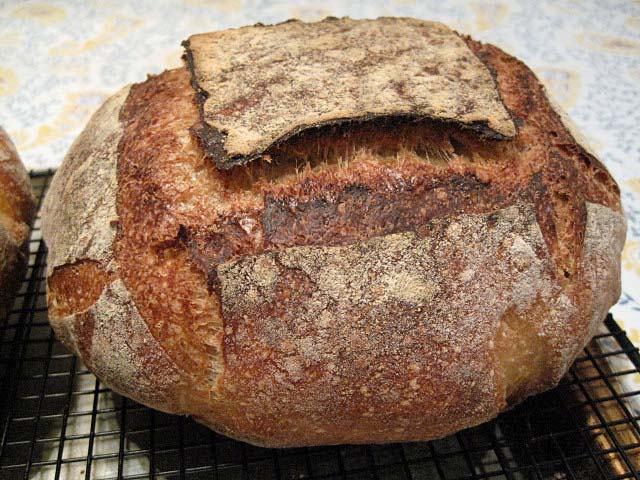
I have made the Basic Country Bread from Chad Robertson's “Tartine Bread” twice before. (See: Tartine Basic Country Bread as Bâtards and Oven steaming using the SFBI method) However, I did not bake the loaves in the cast iron “cloche” that Robertson prescribes. I baked them on a pre-heated baking stone and used the SFBI oven steaming method or the "magic bowl" technique.
Caroline (“trailrunner” on TFL) recently blogged on Vermont Sourdough with Increased Whole Grain from Hamelman's “Bread” which she baked in Dutch Ovens – one cast iron and the other enameled cast iron. Her beautiful loaves finally pushed me to try this method with the Basic Country Bread. (See: David's Vermont SD w/ increased rye ---response to cast iron bake)
Caroline used an heirloom cast iron Dutch oven and a Le Creuset Dutch oven. There was no difference in her results. I decided to try a similar experiment with two other cloches: A 5 qt Copco enameled cast iron pot that was a wedding present (which means we've had it for going on 44 years) and a 4 qt Calphalon anodized aluminum all purpose pan.
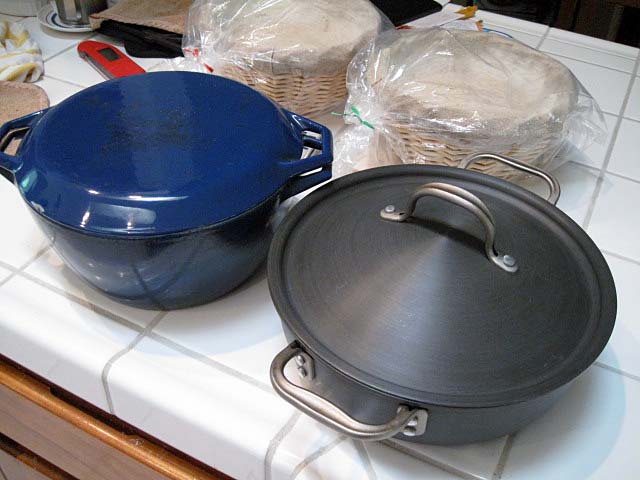
Copco enameled cast iron on the left and Calphalon Anodized Aluminum Dutch Ovens
I made the dough according to Robertson's instructions. I followed Carolyn's well-described method for baking, except that I placed my cloches right on the oven rack, rather than on a baking stone.
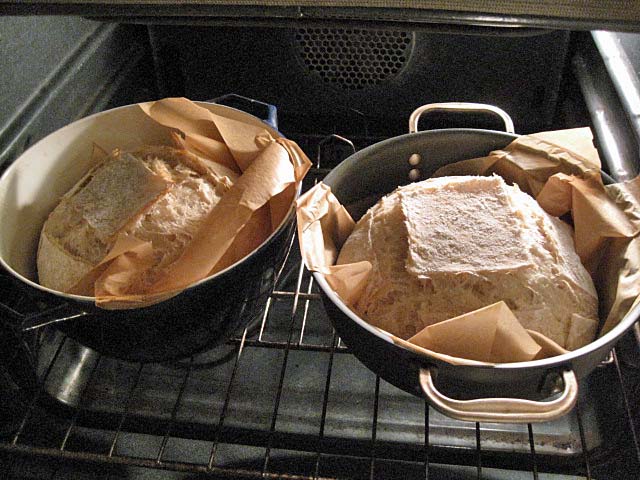
Loaves uncovered after baking 20 minutes covered at 460ºF.
I baked the loaves for an additional 25 minutes after uncovering them to achieve the crust coloration seen below. I think I could have baked a bit longer to get as dark a crust as those in pictured in "Tartine Bread."
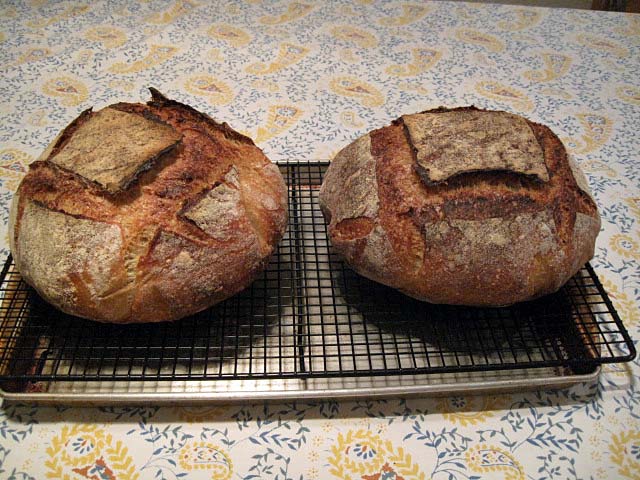
Loaf baked in Copco, on the left, and loaf baked in Calphalon, on the right
Both loaves had great oven spring and bloom. The one baked in the Copco oven had significantly great height, but I don't know whether this had anything to do with differences in thermal properties between the two "cloches" or simply reflects differences in their shape and/or volume. Certainly, there was no significant difference in the crust appearance.
The prolonged high heat did discolor the handles of the Calphalon pan. The Copco interior discolored quite a lot. I don't know if this was from the heat or, possibly, from the parchment paper. Anyone who can share experience with this would be appreciated.
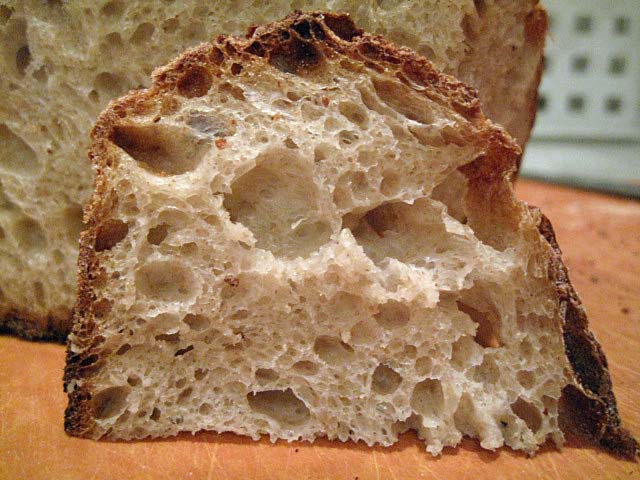
The crust is staying crisp as the bread cools. The crumb is well aerated but less open than that of the bâtards I made. It is tender and has a lovely wheaty-sweet flavor with a mild but definite sourdough tang.
I must say I am very favorably impressed with the results of baking this bread in the Dutch ovens. I think the oven spring and bloom are remarkable and much more dramatic than what I have seen with baking on an oven stone covered with a stainless steel bowl. I'll have to try this technique with other breads, but trailrunner's results with the lower hydration Vermont Sourdough certainly suggest my experience will be repeated.
Thanks for the prompt, trailrunner!
David
Submitted to YeastSpotting
- dmsnyder's Blog
- Log in or register to post comments
Beautiful David! I've not baked from Tartine Bread, but for any formula the oven spring you show here is awesome. I look forward to the crumb shots and the tasting report. You and Trailrunner are challenging me to dig out the old Lodge dutch ovens left over from Boy Scout days and give this a go!
We have neither Copco nor Calphaoln, but we do have a (brand name unknown) enamel-lined cast iron cookpot that we use, especially in winter, to prepare soups and stews on the wood stove we use for heat. It is not at all unusual for that pot to be quite discolored after a few hours on the wood stove. I usually use a Scotch Brite scrub pad on it, and it comes clean pretty easily. I hope yours come as clean so easily.
OldWoodenSpoon
Do not deprive yourself! This is a wonderful bread.
Based on today's experience, I'd say put those old Dutch ovens back on active duty.
I took some Scotch Brite to the Copco, and it does help, but it's taking a lot of work for a slight improvement. I'll soak the pot overnight, but I'm not optimistic about it helping much.
I'm still wondering if the parchment paper contributed to the staining.
David
Hello,
Glad to see you had another successful bake with the Country Bread - two very nice loaves you've got there!
I'm going to have to try and make room in the kitchen for a big cast iron pot so I can give this baking method a try...
it produces a lovely result as you've demonstrated.
Apart from the beautiful bread it produces, I also find the cast iron pot's 20-minute preheat time attractive...
much less than what my baking stone requires.
Regards, breadsong
Good point about the shorter pre-heat time.
David
Great Bake, David! Nice crust you got there, i believe that the concept of Baking bread in Dutch ovens will still be a favorite for home bakers for generations to come.
I'll be posting more on this technique. Preview: It turns out to be an ancient method, not invented by Jim Lahey after all.
David
Those loaves look absolutely great!
I've ordered the book and I have a DO, I must try this sometime soon :). Though I'm a bit nervous about the idea of handling a hot and heavy pot...
I used heavy duty oven mitts, and I highly recommend using them when handling the heavy Dutch ovens.
Thanks for your kind words.
David
Wow....those are gorgeous loaves and a great write up. You might try Bar Keepers Friend on your pots. If you wet it and leave the paste a short time it will make all things clean ! I have left it a lot longer than the label dictates on my copper pots and it is OK.
Otherwise switch to black Lodge Logic cast iron and then the issue becomes moot :)
I will comment on the " hot pot" issue. If you read Farine's blog she has recently posted her bakes using a cold pot in order to avoid lowering a loaf into a hot pot and the lengthy preheat. Her loaves look great so this is going to be my next project. I will post back.
Meantime I may have to get the Tartine book but I really don't need another since I have found that almost all of my bakes are derived from your formulas ! Maybe I need to compile a book of your formulas :) Caroline
I'm not aware of "Bar Keepers Friend," but I'm going to look for it. Sounds useful. We have several enameled cast iron pots that could use cleaning.
I've already decided to order a Lodge Combo Cooker. My wife did not appreciate the stained handles on the Calphalon, to put it mildly.
I'll watch out for your report on the cold pot start.
Thanks for your kind words, but my formulas are not original, with a couple exceptions, and even those were based on ideas gleaned from other TFL members, including you.
David
I am presently cursed with an oven which will not regulate with a stone inside. A major disappointment as the old oven it replaced was great for many many years--until the digital control thingy died. I tried a bit of trouble shooting, but it was something with where the thermostat was and where the stone had to go. No cure but buy another $$$$ oven!
Anyway I have had to give up fun artisan breads and stick with pan loaves for the past year. These pots seem to work nicely on artisanal boules, no batards alas, and now I can bake real bread again!
It's off to the store to get a Lodge cook pot with no legs (I have a monster Dutch oven for camping). Oh, and make another starter. Woo hoo!
Oblong fish poaching pans and baguettes? Stop it Steve, stop it! This type of baking could go a lot of directions.
Lovely lovely loaves!
Cooking in a pot may be your answer. Let us know, please!
As far as bâtards go, there are oval enameled cast iron ovens. Some one suggested Granite Ware also works, and that's a fraction of the cost of Le Creuset, for example.
David
I was in World Market the other day and noted they have Le Creuset type enameled cast iron in different shapes & colors. I have no idea how they'd hold up, but now I'm going to have to go get one to check it out. There was one shape that would work for batard's in addition to the stock pot for boules. BTW, they also carry imported 00 flour in the Italian foods section.
My mother used to boil water and use diluted white vinegar in her pots to clean stains.
Beautiful breads David & trailrunner!
Toni
Agree that baking in covered cast iron is especially suited to those of us who must contend with old, cranky ovens (like mine).
BTW, you [i]can[/i] use a round dutch oven for a batard.
The loaf was baked in a 5-quart dutch oven.
That's awesome ovenspring! Now I see why the book recommend to use this baking method. I might have to go get a dutch oven.
We have a number of enameled cast iron pots, mostly Le Creuset, varying from 1.5 qt to 7 qt size. We use them very often. Nothing is better for braising - stews, daubes, coq au vin, thick soups, rice/meat dishes. I'd think they would be perfect for Chines clay pot dishes, if you don't have Chinese clay pots.
With this bake, I also found that I can bake two large boules simultaneously that would not both fit on my baking stone. That's a big plus for me.
David
Those are magnificent, David! Great bloom and crust color. Your experience has convinced me that I have to try this method. And also that I'm going to get a Lodge Logic dutch oven so as not to risk Cat's heirloom enamel one.
Thanks.
Glenn
My experience convinced me, too!
I just can't decide whether to get one or two Combo cookers.
David
David, the discoloration of the enamel is not from the parchment. I have white Le Creuset pots that will discolor if I use them as a cloche, and I don't use parchment inside.
I think the best way to clean enamel cast iron is to soak the pan in a light bleach solution (maybe a 1:3 clorox to water solution). If you leave it for a few hours or overnight, there is no scrubbing needed and the pan looks good as new.
I'll give bleach a try.
Does the bleach just "bleach" the stain, or does it actually dissolve it?
David
It dissolves it. I think you'll be amazed at the results.
David
at the 1:3 (bleach:water) suggested.
I was going to post the same suggestion (& same ratio). Have used this method for years. Works great. Doesn't damage the enamel. Just wash and rinse the pot as usual once the discoloration is bleached out.
I am glad to see your results using this method. Probably all of us are wondering what we have on hand that would deliver similar results. Years ago I purchased a clay Cloche cooking bell that I drag out when I really want great bloom and nice crust. I'll try the Tartine formula with the clay cooker but I'm certain it will be great.
That is some great looking crumb David.
Eric
David
I seem to have them every where, every form and size, and also have decided to order the Lodge Combo cooker..why..multipurpose, great for bread, easy to clean, and free shipping on Amazon.com! They work perfectly in a WFO's intense heat..it will be used mostly in the wfo, than my indoor oven. I have enamel pots and pans that, very similar to the Le Creuset that are safe up to 700F..but there is the problem of the discoloring in the wfo. They are very hard to clean..I use my dishwasher liquid detergent, straight with no added water and let it soak on the stains and with a bit of scrubbing they come very clean.
I would say IMHO...and past experiences...for baking bread, you just can't beat cast iron, or the LaCloche'.
The Lodge Combo Cooker...Amazon.com has it with free shipping...34.99...take Tartine's word and 'love' the feature on this 'combo' cooker, that you have no high sides to deal with...sooo much safer, and easier to get your bread into...plus the added advantage of the heat from the cast iron.
I have also used this very old Daisy clay pot in a 500F oven, baking bread. Works great! I picked it up years ago for $20 on e-bay. It holds a small boule, with the doomed top it holds apx. 5 qts. It's very much like using the clay la cloche'.
Pictured below: Daisy MarCrest Clay Baker...there are no vent holes in the lid. If pre-heated with the oven, I have heated it up to 500F convection.
Sylvia
Especially the one on the left. I had a very large set of CAA pots and pans, roasters and gave them all away...just me...when I called chefs and the company about the use of aluminum..'I never really understood how the material worked in these pots' but just was leary and do cook a lot of tomato based dishes, too...they would not respond..but aside from that...I think the lack of oven spring was from the CAA pot. I'm just picky, but I also got rid of all my non-stick and now use the new diamond swiss non stick pans...love them!
ADDED: I agree you don't need the stones in your oven when using the D.Oven.
Sylvia
Your Daisy pot is beautiful.
David
Thank you, David! I liked that on the orginal boxes, it said they could withstand heat up to 500F. It's been a while..but once when looking for enamel dutch oven types, these were lighter more like the spotted enamel ware, there were several in Walmart with the metal knobs...I was amazed, around $10, they looked like they had a very good potenial for baking bread. Walmart and Ace Hardware also carry Lodge cast iron pans...I've only seen the fry pans in my closest Walmart, and haven't looked at AceH..though they show the combo cooker online.
Sylvia
Lovely looking boules - both. And your scoring bloomed really nicely. I don't have a cloche or dutch oven, but I'm now a believer in what they can produce.
Nice bakes as usual!
Larry
David
Hi David,
Whoa! So that's what happens when a cloche is used. Those loaves are beautiful! As I mentioned on Caroline's thread last night, I'm doing the same bread but one in the cloche and one on the stone. The cloche baked loaf just went in the oven, so I should have a good idea how it's going to look in about 17 minutes or so. If mine turn out half as nice as yours I'll be very pleased. Love the crumb you got on your loaves.
Franko
A cast iron dog house? Might be useful if the Copco doesn't come clean. [smieyface]
Glenn
Susan is not so attached to the Copco as to the Calphalon, and the former appears to be responding well to the bleach/water soaking. (Yay!)
Be that as it may, an outside cast iron dog house does sound very rustful, especially in today's rainy weather. A true cast iron lodge.
David
Beautiful, David!
Great crumb! And gorgeous crust. Nice and thick and .... I think I need to go eat a slice of Tartine Country bread!
Thanks!
Jay
Everyone should keep a loaf handy for similar emergencies!
David
The Tartine Country loaf is certainly a winner for emergencies for it seems to hold better than any bread other than Pane Genzano. Perhaps I will have to put Tartine bread in my Survival kit! :o)
Look forward to your next adventure!
Jay
one question? Since you did not use a stone, was your bread chared on the bottom at all? All my breads are baked this way with parchment. I thought the parchment caused the charing, maybe not.
Thanks
Paul
The bottoms of both loaves were very dark - not quite charred, but close.
I moved by oven rack down a bit to make access to the covered pots easier. I think that was a mistake.
David
I don't think so. My rack is as high as I can get it (boy that sounds x-rated) and still allow the lodge to fit. Doesn't seem to matter. Maybe I''ll try a cold bake, no parchment.
I also remove the parchment after the covered bake (approx. 30 mins.) and finish on the stone for even browning. The bottom is pretty dark after only the covered bake, the rest of the loaf catches up later.
Paul
Here's my solution: I scatter a thin layer of coarse corn grits on the bottom of the pot right before I put in the dough to bake. This provides a buffer for the bottom heat and prevents scorching the bottom of the loaf. Wheat bran - or anything coarse - would work.
[b]LOAF BOTTOM WITHOUT BUFFER[/b]
[b]CORN GRITS LAYER AFTER THE BAKE[/b]
Corn grits are charred...
[b]SAMPLE LOAF BAKED IN CAST IRON DUTCH OVEN AT END OF BAKE[/b]
[b]NO SCORCHING OF BOTTOM FOR THIS LOAF[/b]
[url=http://www.flickr.com/photos/92184747@N00/5189931709/]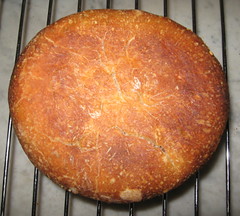 [/url]
[/url]
Maybe I'll try rice. Always lots of that around.
Thanks
Paul
If you try rice, let us know how it turns out.
I'm a dedicated home-miller, so I mill corn grits from popcorn (can't get dent or field corn where I live).
I've been thinking of using cheap white rice and maybe milling it very coarsely. Cheaper for me than popcorn.
I doubt that anyone will see this, since my post is so late.
I have tried using home milled rice grits as a buffer to prevent scorching of the bottom of bread baked in a cast iron dutch oven.
Since I own a grain mill, I milled some cheap white rice to a granular consistency. The white rice was somewhat pebbly (like *very coarse* sand) to the feel.
I used this to prevent scorching of bread baked in a cast iron dutch oven. The rice grits were scattered over the bottom of the dutch oven, a round of parchment paper was placed over the scattered rice grits, and the loaf was baked.
While I found that rice grits (with a layer of parchment paper on top) did prevent scorching of the bottom of the loaf, I didn't feel it was as effective as a layer of coarse milled corn grits (which, as a home miller, I mill from supermarket variety popcorn).
In both experiments, the grits + parchment paper solution prevented scorching of the bottom of a loaf baked in a cast iron dutch oven. In both experiments, the grits layer (whether from corn or rice) was slightly scorched.
However, I felt that the corn grits were slightly more successful. Corn grits seem to contribute a small amount of moisture to the covered cast iron pot whereas the rice grits do not.
Since the cost (to me) of cheap refined white rice and (supermarket) whole corn popcorn is about the same, I have decided to stay with corn grits milled from supermarket whole popcorn for this problem.
I have several concerns about using dutch ovens.
1. LOTS of parchment paper. Is anyone concerned about using reams of paper for each loaf? I feel bad about setting my loafs on small rounds of parchment - then re-using them as long as they hold up. One day, I hope to get good enough to bake without the parchment.
2. How to deal with the HOT pot! Getting the loaf out with crumbly paper from the hot pot - or do you leave it to cool down? ...See #3.
3. I like to bake 8 loafs in one oven heating. I don't have that many dutch ovens - or oven space. So using baking stones & a pan of lava rocks on the bottom of the oven means I can bake 4 loafs at a time.
4. Note: I recently discovered SOAPSTONE! The only U.S. quarry is off Rte 81 in Virginia. We went there & bought 3 huge stones for $150 - we cut them into 9 stones & gave several to friends. They bake better than ceramic baking stones - but are very heavy to handle. They guys at the quarry swear by using them on the grill. If you buy online - the soapstone will be from Brazil (if you care about such things).
David
My lodge combo cookers do not require the use of parchment paper.
I use oven gloves to handle the hot pots. You can click my name to see the gloves I use as posted in one of my first entries.